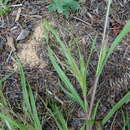Comprehensive Description
provided by North American Flora
Panicum gattingeri Nash, in Small, Fl. SE. U. S. 92, 1327. 1903
Panicum capillare campestre Gatt. Tenn. Fl. 94. 1887. Not P. campestre Nees, 1826.
Panicum capillare geniculatum Scribn.; Kearney, Bull, Torrey Club 20: 477. 1893. Not P.
geniculatum Lam. 1798. Panicum capillare Gattingeri Nash, in Britt. & Brown, 111. Fl. 1: 123. 1896.
Plants at first erect, but soon decumbent-spreading and rooting .at the lower nodes, freely branching from the lower and middle nodes; culms papillose-hispid, in robust specimens as much as 1 meter in length; leaf -sheaths hispid like the culms; blades 10-20 cm. long, 6-10 mm. wide, narrow to a rounded base, more or less hispid on both surfaces or nearly glabrous; panicles numerous, terminating the culms and main branches and axillary at most of .the nodes, shortexserted or, especially the axillary, included at base, oval or elliptic in outline, the terminal 10-15 cm. long, two thirds as wide, the lateral smaller, rather densely flowered, the branches 219
ascending or tardily spreading; spikelets shorter-pediceled than in P. capillar e and more turgid, 2 mm. long, 0.9-1 mm. wide, elliptic; first glume about two fifths as long as the spikelet, acute or blunt; second glume and sterile lemma equal, 5-nerved, but slightly exceeding the fruit, the palea of the sterile floret wanting; fruit 1.6 mm. long, 0.8 mm. wide, elliptic.
Type locality: Tennessee.
Distribution: Pennsylvania to Minnesota, and south to Tennessee.
- bibliographic citation
- George Valentine Nash. 1915. (POALES); POACEAE (pars). North American flora. vol 17(3). New York Botanical Garden, New York, NY
Comprehensive Description
provided by North American Flora
Panicum philadelphicum Bernh. ; Trin. Gram. Pan. 216. 1826
Panicum capillare sylvaticum Torr. Fl. U. S. 149. 1824. Not P. sylvaticum Lam. 1798.
Panicum porphyrium Trin.; Nees, Agrost. Bras. 198. 1829.
Panicum Torreyi Fourn.; Hemsl. Biol. Centr. Am. Bot. 3: 497. 1885.
Panicum capillare minimum Hngelm.; Gatt. Tenn. Fl. 94. 1887.
Panicum minimum Scribn. & Merr. Circ. U. S. Dep. Agr. Agrost. 27: 4. 1900.
Panicum soboliferum Tuckerm.; Scribn. & Merr. Rhodora 3: 106, as synonym. 1901.
Plants light yellowish-green, in small tufts, freely branching, erect or rarely decumbent at base, 15-50 cm. high, depauperate northern specimens sometimes forming small mats; culms slender, papillose-hispid to nearly glabrous, more or less zigzag at base, the lower internodes much shortened; leaf -sheaths mostly longer than the internodes, papillose-hispid; blades erect or ascending, 4-15 cm. long, 2-6 mm. wide, rather sparsely hirsute, rarely nearly glabrous; panicles exserted, diffuse, ovoid, 10-20 cm. long, forming one third the entire height of the plant or more, few-flowered, the capillary, scabrous branchlets solitary, bearing rather shortpediceled spikelets, usually in twos, at the ends; spikelets 1.7-2 mm. long, 0.7 mm. wide, elliptic; first glume about two fifths the length of the spikelet, 5-nerved, acute; second glume and sterile lemma equal, only slightly exceeding the fruit, the palea of the sterile floret wanting; fruit 1.5 mm. long, 0.6 mm. wide, elliptic.
Type locality: Philadelphia.
Distribution: Maine to Wisconsin, and south to Georgia and Oklahoma.
- bibliographic citation
- George Valentine Nash. 1915. (POALES); POACEAE (pars). North American flora. vol 17(3). New York Botanical Garden, New York, NY
Physical Description
provided by USDA PLANTS text
Annuals, Terrestrial, not aquatic, Stems nodes swollen or brittle, Stems erect or ascending, Stems geniculate, decumbent, or lax, sometimes rooting at nodes, Stems caespitose, tufted, or clustered, Stems terete, round in cross section, or polygonal, Stems branching above base or distally at nodes, Stem nodes bearded or hairy, Plants conspicuously hairy, grayish, or wooly, Stem internodes hollow, Stems with inflorescence less than 1 m tall, Stems, culms, or scapes exceeding basal leaves, Leaves mostly cauline, Leaves conspicuously 2-ranked, distichous, Leaves sheathing at base, Leaf sheath mostly open, or loose, Leaf sheath smooth, glabrous, Leaf sheath hairy, hispid or prickly, Leaf sheath hairy at summit, throat, or collar, Leaf sheath and blade differentiated, Leaf blades linear, Leaf blades 2-10 mm wide, Leaf blades mostly flat, Leaf blades mostly glabrous, Leaf blades more or less hairy, Leaf blades scabrous, roughened, or wrinkled, Ligule present, Ligule a fringe of hairs, Inflorescence terminal, Inflorescence an open panicle, openly paniculate, branches spreading, Inflorescence solitary, with 1 spike, fascicle, glomerule, head, or cluster per stem or culm, Inflorescence branches more than 10 to numerous, Flowers bisexual, Spikelets pedicellate, Spikelets dorsally compressed or terete, Spikelet less than 3 mm wide, Spikelets with 1 fertile floret, Spikelets with 2 florets, Spikelet with 1 fertile floret and 1-2 sterile florets, Spikelets solitary at rachis nodes, Spikelets all alike and fertille, Spikelets bisexual, Spikelets disarticulating below the glumes, Rachilla or pedicel glabrous, Glumes present, empty bracts, Glumes 2 clearly present, Glumes distinctly unequal, Glumes equal to or longer than adjacent lemma, Glume equal to or longer than spikelet, Glumes 4- 7 nerved, Lemma similar in texture to glumes, Lemma 5-7 nerved, Lemma glabrous, Lemma apex acute or acuminate, Lemma awnless, Lemma margins inrolled, tightly covering palea and caryopsis, Lemma straight, Palea present, well developed, Palea about equal to lemma, Stamens 3, Styles 2-fid, deeply 2-branched, Stigmas 2, Fruit - caryopsis, Caryopsis ellipsoid, longitudinally grooved, hilum long-linear.

